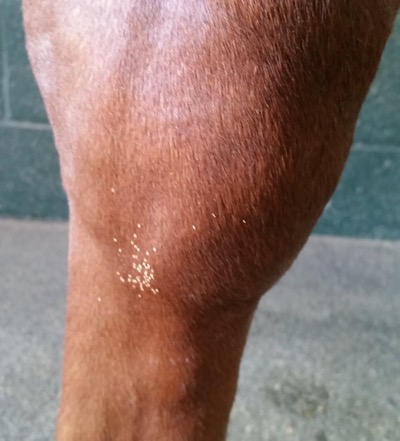Many horse owners are horrified to see bot fly larvae in the stomach of their horses when checked for gastric disease. Although alarming to owners they have minimal to no impact on the health of the horse. There is also evidence that gastric bot fly larvae are becoming less prevalent in domestic horse populations, likely as a by-product of de-wormer use. Bots are not worms, they are flies.
Life Cycle
Female Gasterophilus flies lay their eggs on horse hairs around the lips, chin, cheeks and forelegs during summer. The eggs are stimulated to hatch after mechanical stimulation and moisture provided by grooming activity. Most people think that infection is caused by direct ingestion of the eggs, this is not true. Many eggs are laid in sites that cannot be directly reached by the horse’s mouth. After hatching the first instar larvae burrows into the horse at the site of egg emergence and migrate to the horses oral cavity where they penetrate the top of the tongue. They migrate either side of the tongue from front to back. Second instar bots can also be found in gingival pockets at the base of molar teeth and attached to the pharynx and epiglottis. They reside in the oral cavity for a few weeks. They then pass into the stomach, where they stay around the margo plicatus (on both the glandular and non-glandular sides) for around 10 months before moving through the gastrointestinal tract and passed in manure, typically in spring and early summer. They pupate in the soil and develop into adult flies after about 2-5 weeks, and mate soon after. Somewhat ironically the adult flies only live for 3-5 days. The flies resemble small bees, but do not bite or sting.



There are several species of Gasterophilus known to infect horses, with Gasterophilus intestinalis the most common. Other species include G. nasalis, G. pecorum, and G. hemorrhoidalis.
Based on the life cycle of the parasite there is a seasonal cycle with respect to expected numbers of bot flies seen on gastroscopy. The lowest numbers, as expected, will be in spring and early summer. The peak time to see bot fly larvae is in Autumn.
The chart below illustrates the seasonality of certain parasites in France. Note the top box which demonstrate that stomach bots (Gasterophilus species) peak in number in late Autumn.

Signs
Bot fly larvae are typically benign, and only cause a problem on very rare occasions. A reasonable load of gastric bot fly instars could be predicted by a large number of bot fly eggs in summer and autumn. It could be argued that the greatest impact of bots is through annoyance during egg deposition in summer.
Attachment to the mucosa in the stomach does leave a small ‘pit’ that is surrounded by some proliferation of mucosa. These pits are superficial and have little to no impact on the host.



Control
It is important to remember that the natural life cycle will see gastric instars being cleared from the stomach without any therapy.
Currently the macrocyclic lactones are the only anthelmintics with declared efficacy against bots, although recent evidence suggests that moxidectin is the least effective in this category. This is not surprising as moxidectin is less effective against arthropod targets than other macrocyclic lactone parasiticides, such as ivermectin or abamectin. Horses treated with moxidectin did have a reduction in bot fly larvae compared with untreated controls and fenbendazole horses, but only had an estimated efficacy of 60%. As expected horses treated with fenbendazole daily for 5 days had no significant reduction in Gasterophilus 3rd instar counts versus untreated controls. Benzimidazoles have no activity against arthropods.
Recommendation: Do not be tempted to treat small numbers of larval instars seen on gastroscopy – they really aren’t important. If are going to treat with anything, then consider using ivermectin or abamectin; not moxidectin once yearly in Autumn.
Remove bot eggs in summer and autumn using a bot knife, abrasive sponge or stone (see below, although please note that this video contains some incorrect facts about bot flies)
Tags: Parasites; Gastrointestinal diseases
